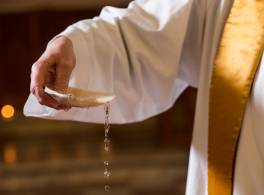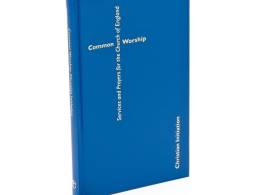based on notes prepared by the Liturgical Commission
Notes ↑
The new texts, comprising
¶ Presentation of the Candidates,
¶ The Decision,
¶ Signing with the Cross,
¶ Prayer over the Water and
¶ Commission,
are all alternatives to the existing provision in Common Worship: Christian Initiation. Any one of the five sections may be substituted for the equivalent section in Common Worship. It is not necessary to use all the alternative sections together. However, each of these sections has an integral structure, so where one of the alternative sections is used, that section should be used in its entirety: existing and additional provision should not be combined within a given section.
To make a baptism service accessible to those who are not used to being in church is to think seriously both about the texts that are to be used and about the way the whole rite is articulated – we might say performed. A rite consists of more than words: movement, action, silence and gesture are also of primary importance.
The baptismal liturgy in Common Worship is formed on the assumption that it will be celebrated at a principal service, preferably the Eucharist. When Common Worship Baptism is used as a free-standing service – such as following a principal service on Sundays – it requires adaptation. For instance, a sensitive priest may insert hymns and songs at appropriate points.
What is provided here is the basic simplified track through the Common Worship Baptism liturgy as a separate service, using the alternative forms. The mandatory elements are indicated in the printed edition of this book with a vertical line on the left of the page.
The responses in the alternative material have been simplified, not least to help those who are not confident speaking from a printed text.
When that is the case, a sensitive priest will lead the people to make the responses at the appropriate time.
The Greeting ↑
Frequently parents ask people who have not been baptized to be godparents. This may be a good pastoral opportunity to lead godparents to faith and baptism. However, sometimes a priest is left with the difficult task of explaining that people who are not baptized cannot be godparents because it would be asking something of them that they have not yet taken upon themselves. Using parts of Common Worship: Thanksgiving for the Gift of a Child is one possible solution to this difficulty and the relevant text is printed here.
Introduction ↑
Neither the written Pastoral Introduction nor the spoken Introduction to the service are mandatory texts: parishes may produce their own written introduction and the minister may lead into the service with a scripted or extempore introduction.
The Collect ↑
In contexts where the language of the Collects might present difficulties ministers are encouraged to make use of the Alternative Collects.
The Sermon ↑
The sermon, as a proclamation of the word of the Lord, is an important part of the liturgy. It may take the form of a commentary accompanying the Scriptures as they are read and a succinct explanation of the liturgical actions as they unfold.
Presentation of the Candidates ↑
The Presentation is divided into two options: for infants and for those who can answer for themselves. In the case of children who may not be confident answering for themselves, the priest should use his/her discretion in deciding which form to use. When, at the same service, there are children in both categories, both options may be used.
The use of Mark 10.14 at the baptism of infants is not used as any kind of justification for infant baptism; it is a means of expressing the welcome of Christ and his Church for children, and for the family present at the baptism.
The Decision ↑
The Decision is formed of two pairs of questions. Between the two pairs of questions is the idea of turning around – conversion – and this may be expressed by some action.
¶ The first pair of questions represents a movement of separation from the old order of sin and death, from the old Adam.
¶ The second pair represents a turning towards newness of life and faith in Christ. This can be well expressed through a physical movement of turning; the movement will depend on the layout of the church.
The first pair of questions might typically be answered facing away from the east, and the second pair after turning to face a symbolic location of new life in the risen Christ, such as the font, holy table or Easter candle. (Ministers should think carefully about where they themselves stand at this point, so that the symbolic turning does not appear as a turning towards the minister.)
Signing with the Cross ↑
The roots of this signing lie in the enrolment of catechumens at the beginning of a period of preparation for baptism, a practice that has been renewed in many parishes. The alternative place for the Signing is immediately after the baptism. When the Signing takes place after the Decision, the minister traces the sign of the cross on the candidate’s forehead; s/he may use olive oil (also called the oil of catechumens). Parents, godparents and sponsors may also be invited to sign the candidate (with the oil, if desired). There is rich biblical symbolism associated with anointing: it is an image of cleansing, blessing, consecration to God’s purpose, and of preparation for athletic contest which is itself an image of ‘running the race’ of the Christian life (see 1 Samuel 16.13; Psalms 23.5; 45.7; 133.2). Many parishes use oil that has been blessed by the Bishop, and this is a reminder that each individual baptism is also an act of the whole Church.
Prayer over the Water ↑
Given that water is essential to the performance of a baptism and that the symbolism of water is central to the meaning of the rite, it is worth drawing attention to the water. It can be poured into the font from a jug, visibly and audibly, possibly by a godparent, before the Prayer over the Water.
The opening dialogue, ‘Praise God who made heaven and earth …’ continues to be appropriate but may be omitted. Two prayers are provided. The first uses the imagery of Moses leading the people to freedom through the Red Sea and Christ’s passing through the deep waters of death, leading to prayer that the candidates may die and rise with him and find true freedom as God’s children. The second focuses on Christ’s baptism in the Jordan when the Spirit came on him and he was revealed as the Son God loves, leading to prayer that the candidates may be cleansed and filled with the Spirit so that they, too, may know they are loved as God’s children.
Prayers over the Water are not entirely specific to the individual being baptized so they refer, in the plural, to ‘those who are washed in this water’ and ‘those who are baptized in it [this water]’. There is no need to alter them when one individual is being baptized.
Profession of Faith ↑
The forms provided are those in Common Worship: Christian Initiation.
After the Baptism ↑
No change has been made to the option that, immediately after the baptism, the newly baptized may be wrapped in a white scarf or shawl, symbolic of being clothed with Christ.
Anointing with the oil of chrism may accompany the prayer after baptism, possibly by pouring the oil over the crown of the candidate’s head. Alternatively, if the Signing with the Cross takes place after baptism (rather than as a response to the Decision), oil of chrism may be used for it, and the symbolism of the act is of witness to Christ crucified. Chrism is a fragrant oil, evoking the presence and joy of Jesus Christ, and the blessings of the Holy Spirit.
Commission ↑
In place of the forms of Commission provided in Common Worship two options are provided as alternatives. It is intended that the minister (or other suitable person) will talk directly and simply in his or her own words to the parents, godparents and congregation, or to the newly baptized in the case of the baptism of those able to answer for themselves, covering the topics listed in the bullet-points. Some ministers may find it helpful to speak from these bullet-points, but it is desirable to avoid giving the impression that a written text is simply being read out. As an example, the address might be something like the following:
Parents and godparents, we are glad to have welcomed you here for the baptism of N and N. Today they have joined us on our Christian journey. Baptism unites us with Christ and to his whole Church, on earth and in heaven.
Here, we shall do all that we can to ensure that there is a welcoming place for you. We will play our part in helping you guide these children along the way of faith.
Bringing up children as Christians has its challenges. N and N will need to discover the story of Christ’s birth, death and resurrection, the pattern of his loving life, and the teaching that he gave. We pray that they will come closer to God as they grow in faith, explore the Bible, and make their baptismal promises for themselves when they come to confirmation.
As well as worshipping with the Church, Christians follow Jesus by standing up for truth and justice, and showing compassion to those in need. They are to be faithful and loving. The example that you give by prayer and the life that you lead will affect N and N for their whole life. Remember to ask for God’s help, and pray for them often, as we now pray for you.
Or, at the baptism of those able to answer for themselves:
N, we are glad to have welcomed you to (name of church) for your baptism. There will always be a place for you here. Your baptism joins you to Christ and to his whole Church, in every part of the world, in the past and in the future, on earth and in heaven.
Even before today, God began his work in you, but it will take the whole of your life to complete that work. There will be moments when the journey ahead is a delight and there will be times when it is hard, but you will never be alone. You will always have the support of other Christians. There will be many milestones on your journey: confirmation will be one of them.
Remember that in Jesus heaven has touched our world. Belonging to him will change your life and, through reading the Bible, you will learn more deeply the story of God’s love. Through worship, prayer and caring for others you will grow more and more like Jesus. Stand up for fairness, truth and kindness.
God’s love is for you, and for everyone. Share with other people the good news of his love.
Welcoming someone into the congregation ↑
When a baptism is celebrated within Holy Communion, the Welcome and Peace should follow, rather than precede, the Prayers of Intercession.
Since a baptism is a public event, where a baptism has taken place at a separate service, the family may be invited to return at a principal service for the child to be welcomed by the wider congregation.
The Giving of a Candle ↑
Many parishes give a candle to the newly baptized; this may be lit from the Easter candle in churches which use one, and will sometimes be a miniature copy of the Easter candle. It needs to be clearly explained that the candle is for the family to take home. They may be encouraged to light it on birthdays, on the anniversary of baptism or on other special occasions.
Page numbers ↑
See Common Worship: Christian Initiation, CHP 2006 ISBN 0 7151 2102 2
Common Worship: Christian Initiation - Additional Baptism Texts in Accessible Language, material from which is included here,
is copyright © The Archbishops' Council 2015 and published by Church House Publishing.


